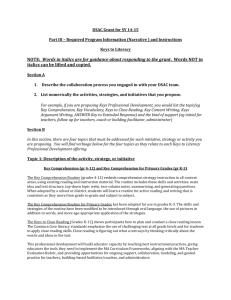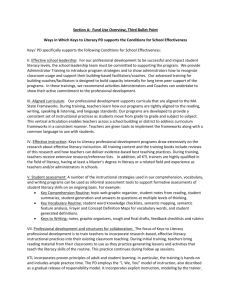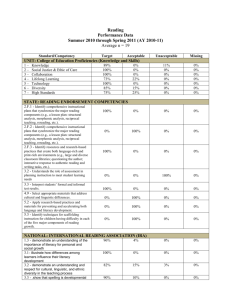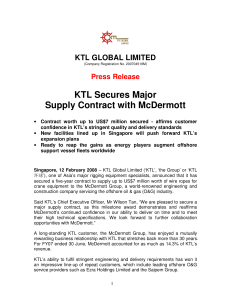DSAC RFP for Districts for 2014-15 – Vocabulary
advertisement
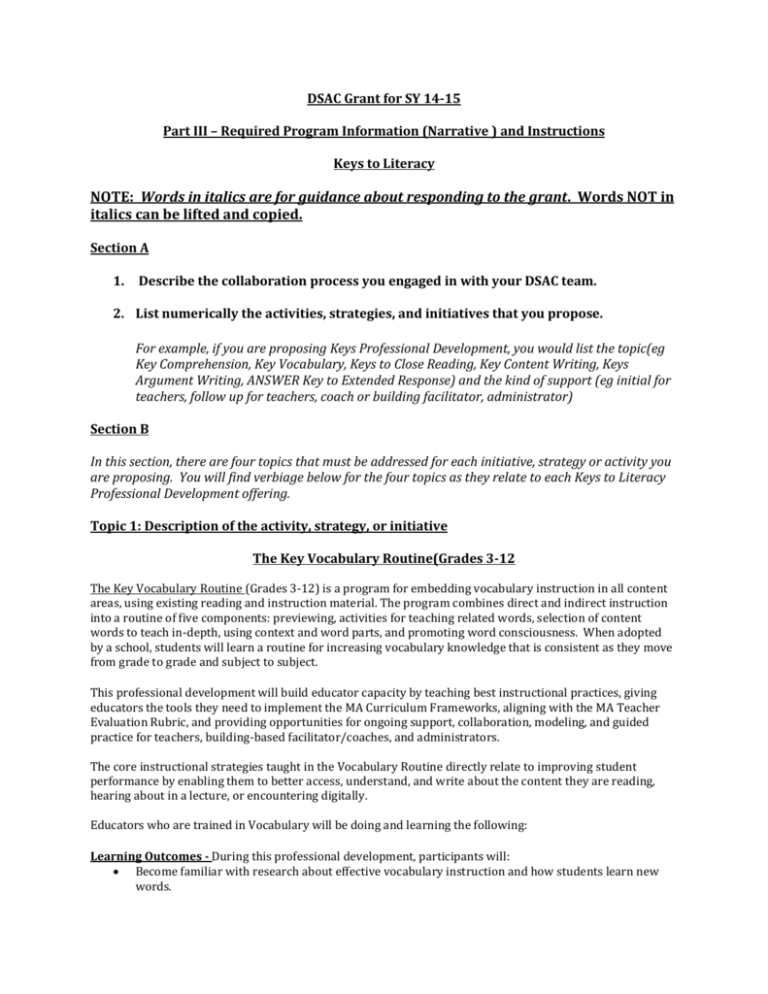
DSAC Grant for SY 14-15 Part III – Required Program Information (Narrative ) and Instructions Keys to Literacy NOTE: Words in italics are for guidance about responding to the grant. Words NOT in italics can be lifted and copied. Section A 1. Describe the collaboration process you engaged in with your DSAC team. 2. List numerically the activities, strategies, and initiatives that you propose. For example, if you are proposing Keys Professional Development, you would list the topic(eg Key Comprehension, Key Vocabulary, Keys to Close Reading, Key Content Writing, Keys Argument Writing, ANSWER Key to Extended Response) and the kind of support (eg initial for teachers, follow up for teachers, coach or building facilitator, administrator) Section B In this section, there are four topics that must be addressed for each initiative, strategy or activity you are proposing. You will find verbiage below for the four topics as they relate to each Keys to Literacy Professional Development offering. Topic 1: Description of the activity, strategy, or initiative The Key Vocabulary Routine(Grades 3-12 The Key Vocabulary Routine (Grades 3-12) is a program for embedding vocabulary instruction in all content areas, using existing reading and instruction material. The program combines direct and indirect instruction into a routine of five components: previewing, activities for teaching related words, selection of content words to teach in-depth, using context and word parts, and promoting word consciousness. When adopted by a school, students will learn a routine for increasing vocabulary knowledge that is consistent as they move from grade to grade and subject to subject. This professional development will build educator capacity by teaching best instructional practices, giving educators the tools they need to implement the MA Curriculum Frameworks, aligning with the MA Teacher Evaluation Rubric, and providing opportunities for ongoing support, collaboration, modeling, and guided practice for teachers, building-based facilitator/coaches, and administrators. The core instructional strategies taught in the Vocabulary Routine directly relate to improving student performance by enabling them to better access, understand, and write about the content they are reading, hearing about in a lecture, or encountering digitally. Educators who are trained in Vocabulary will be doing and learning the following: Learning Outcomes - During this professional development, participants will: Become familiar with research about effective vocabulary instruction and how students learn new words. Learn to teach vocabulary embedded in classroom instruction using content reading material. Learn how to develop lesson plans that use previewing activities and activities for teaching words in relation to other words (i.e., semantic mapping, categorizing, semantic feature analysis, scaling). Learn a three-tiered model for identifying specific content words to teach in-depth using activities such as the Frayer model, the Concept Definition model, and the Two-Column model. Learn how to teach use of context and word parts to learn new words. Learn how to develop a word-conscious classroom. Receive guided practice and feedback for developing lessons using these skills and strategies. Share and learn from peer teachers during small-group sharing meetings facilitated by a trainer. Syllabus - Participants should bring classroom reading materials to use during initial training. Day 1 Review of essential teaching principles: gradual release of responsibility, scaffolding, differentiated instruction modeling Overview of the five components of reading; the role of vocabulary in comprehension Review of the research on effective vocabulary instruction and how students learn words Previewing for difficult vocabulary: how to identify words, student rating checklists, how to preview Using activities to teach words in relation to other words o Developing a schema to connect new words with background knowledge o 4 research-based activities: Semantic Mapping, Categorizing, Semantic Feature Analysis, Scaling o Practice using the activities with classroom content words Day 2 Selecting words to teach in-depth o Three-tiered model for selecting words o Rich vocabulary instruction; teaching everything about a word o Research-based activities for teaching specific words: Frayer, Concept Definition Map, 2Column o Instruction for Academic Vocabulary o User-friendly definitions; use of dictionaries Practice selecting and teaching content specific words Word Learning Strategies o Teaching use of context o Word families and teaching word parts (suffixes, prefixes, roots) Practice use of context and word parts using content specific words and reading material Promoting word consciousness o Word rich classrooms and word play o Word walls o Classroom reading materials In order to have a lasting, sustainable impact on instruction, quality professional development must be more than individual workshops or training days. The KTL professional development model includes hands-on initial training that shows teachers how to apply research-based instruction. They also include follow-up PD provided by KTL trainers AND building-based peer coaches, with an emphasis on peer collaboration. Follow up support follows the Gradual Release of Responsibility Model, also known as I-We-You, where KTL trainers demonstrate the PD skills early in adoption, then work with educators to develop lessons together and apply the strategies, before finally turning responsibility over to teachers for independent use. In addition, district and building administrators are trained to recognize and set expectations for program usage and to support teachers and coaches as they implement the strategies. Timeframe, Participants, & Funding – see the chart below, including the sample. Schools Involved & Their Level Number of Participants per School Keys PD Topic Eg Powers Middle School – Level 3 Powers: 35 SS, Science, ELA, Math & Special Ed teachers. Key Vocabulary Type of Support/ Provided by Whom? Initial Training/KTL. Coach Training/KTL. On-going Teacher Support/KTL & building coaches. Timeframe DSAC Funds Needed Initial: Jan, 2015 two days. $XXXX for consultants Coach: Feb 2015 two days On-going: Three days Mar-June, 2015 $XXXX for substitutes $XXXX for stipends $XXXX for materials $XXX for travel PD Provider/Facilitator Name: Keys to Literacy 319 Newburyport Turnpike, Suite 205 Rowley, MA 01969 www.keystoliteracy.com 978-948-8511 Keys to Literacy is responsible for providing literacy professional development for administrators and teachers in grades K-12. Keys to Literacy meets the MA Standards for High Quality Professional Development (HQPD), is an approved state professional development provider, and has been pre-qualified to offer PD from the DSAC PD menu. KTL has 11 trainers, all of whom have at least a Master’s degree in Reading or a related field and many years of experience in the classroom as teachers and administrators and in PD as teacher trainers and literacy experts. Resumes are available on request. Topic 2: Rationale for selecting this activity, strategy, or initiative Here, they want you to address: The strategic goals the activity supports The educator, school and/or district needs being addressed How the activity addresses and supports these goals. Possible verbiage to include: o This PD addresses needs identified from standardized testing and supports better instructional practices on the part of our teachers. It is research-based and is evaluated continually to ensure it meets the stated needs. In addition, Keys PD promotes collaboration among educators, is taught by knowledgeable professionals, and provides a coherent and cumulative learning experience for educators. How the activity connects to one or more of the indicators in ESE’s Conditions for School Effectiveness. Possible verbiage to include: o KTL PD supports the following Conditions for School Effectiveness: 1) developing effective school leadership via administrator and coach training; 2) developing effective instructional practices using research-based strategies and support; 3) providing the opportunity for a variety of informal assessment tools of student literacy; 4) professional development with a job-embedded approach that is content-oriented and has multiple opportunities for collaboration; and 5)support for Tier I and Tier II instruction. What makes the activity a high-leverage strategy that will contribute to turnaround efforts. Possible verbiage could be: o (If this plan is to provide more support for PD in which teachers have already been trained): Our teachers have already been trained in these strategies and they need more on-going follow up support in their classrooms to ensure they are using the skills often and with fidelity. Teachers have reacted favorably to the PD, stating that it is practical and easily adaptable, so we expect it to be used and to impact turnaround efforts. Also, KTL has MA state survey data showing that 90% of trained teachers say “the PD enhances my students’ ability to understand the reading and learn my subject area content,” which bodes well for improved achievement. o (If this plan is to provide new PD): We have had positive results with other Keys to Literacy PD and we expect this program to similarly contribute to turn around efforts. How the activity, strategy or initiative will ultimately reach the classroom. Possible verbiage: o Keys to Literacy strategies are practical and immediately adaptable for classroom use. During initial and follow up training, KTL trainers help educators apply the strategies to their own content to be used right away. KTL will also model lessons or observe teachers in their classrooms, and administrators are encouraged to hold teachers accountable for the strategies. Finally, building coaches are on hand to facilitate classroom use. Use of supporting evidence. They want to see the information and evidence you used to identify and select this activity and the process you used to analyze and reflect on this information. Be sure to say who was involved in this selection process. Topic 3: Anticipated changes We expect to see changes in educator knowledge and instructional practices and, ultimately, in students’ ability to independently use the strategies. Early Indicators of change are teacher use of any of the following: Implementation Folders, lesson plans with Vocabulary strategies embedded, and evidence in the classroom of previewing difficult vocabulary before reading, using activities to connect vocabulary to background knowledge and related words, selecting specific words to teach in depth, teaching word learning strategies, and promoting word consciousness. The graphic organizers are a quick visual indicator of changes in instructional practice. Over time, teachers will combine multiple strategies and enable students to use the strategies on their own, with evidence shown in student notebooks. The Walkthrough Guide below shows evidence of use for Key Vocabulary: The Key Vocabulary Routine Administrator Walk Through Are teachers implementing the Key Vocabulary instructional practices in order to address state literacy standards and meet the needs of their students? Place a check in the column for each indicator observed during the visit. Use the space provided to make any notes or reflections to facilitate follow-up discussion with the teacher. Instruction Indicators General Vocabulary Instruction Provides students with explicit instruction about a vocabulary activity or word-leaning strategy, including: set clear goals and directions modeling guided practice independent practice, including opportunities to work in small, collaborative groups to practice use of strategies Embeds vocabulary instruction in content teaching throughout the period/day Avoids identifying a specific time of the week to teach vocabulary Previewing Vocabulary Generates a list of words to preview before students read Uses a Student Knowledge Rating Checklist to have students identify how well they know a word Connecting Vocabulary to Background Knowledge and Related Words Uses any of the following activities: Semantic mapping Categorizing words Semantic feature analysis Scaling Presents and discusses new words in relation to the background knowledge about a topic and other related words Notes and Reflection Selecting Words to Teach In-Depth Uses a framework for selecting a small group of essential content words to teach in-depth Uses any of the following activities to teach a word indepth: Frayer/Four Square Concept Definition Map Two-Column Notes Provides multiple exposures to essential words over time, in meaningful situations Using the Context Identifies opportunities in content reading to demonstrate how use of context may help to determine the meaning of an unfamiliar word Explicitly teaches use of content Teaching Word Parts Explicitly teaches that words have meaningful parts (prefixes, suffixes, roots) Models identification of word parts using content vocabulary Promotes Word Consciousness Encourages students to share new and interesting words Provides access to a wide variety of reading materials Embeds word play activities during classroom instruction Avoids having students memorize dictionary definitions Uses vocabulary word wall lists and changes the words on a regular basis Topic 4: Monitoring implementation and assessing change We will monitor implementation in a variety of ways that align to SMART criteria. First, we will field a pre- and post-survey to assess teachers’ knowledge about the Vocabulary strategies, determine if their usage of strategies is increasing or not, and learn their opinions about the PD’s effectiveness. We will also gather informal feedback from KTL trainers and building coaches about overall evidence of use for the strategies, which can be gained by working with small groups of teachers or observing in classrooms. In addition, Walkthroughs by administrators should be used to track progress. As the follow up sessions progress, we can adjust the focus, frequency or the teachers participating in the sessions to address any issues. Responsibility for monitoring: Identify the person responsible for coordinating this process. The timeline for collecting pre-and post-survey data will be before the first training and after the last, with at least 4-6 months in between. Keys trainers will meet with teachers XXXX times based on the proposed plan, after which KTL will provide a written report for district and building administrators noting general themes or trends. In addition, building coaches will meet with their peers regularly to support use of strategies and understand general progress and themes. Vocabulary-specific Walkthroughs should happen at least twice per 6 months. Results of the surveys, trainer and coach reports, and Walkthroughs with trends will be shared with the teachers as they are available.
